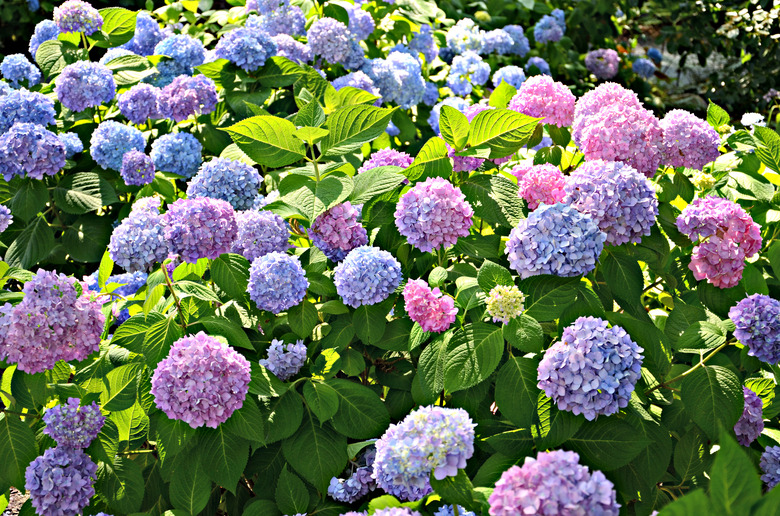Companion Planting For Hydrangeas
A classic element of traditional garden design, hydrangeas (Hydrangea spp.) have been bred to produce a variety of colors, shapes and forms. Choose companion plants that have similar needs to make your garden easier to maintain and to create an attractive display of contrasting colors and textures.
Hydrangea Species
When choosing companion plants for hydrangeas, it's important to consider care requirements as well mature size. Hydrangeas do best with moist, organically rich soil with good drainage. Most species do well in full sun to partial shade but prefer a few hours of morning sun and afternoon shade. Different species of hydrangea have notably different growth habits:
- Varieties of oakleaf hydrangea (Hydrangea quercifolia), which grow in U.S. Department of Agriculture plant hardiness zones 5 through 9, can reach between 8 and 12 feet tall and wide.
- Varieties of smooth hydrangea (Hydrangea arborescens, USDA zones 3 through 9), also called wild hydrangea, only reach 3 to 5 feet tall and wide.
- Bigleaf or French hydrangea (Hydrangea macrophylla, USDA zones 5 through 9), feature the classic mophead or lacecap flower clusters and are either deep blue in acidic soil or pink in alkaline soil.
- Panicle hydrangeas (Hydrangea paniculata, USDA zones 3 through 8) sport cone-shaped white or cream flowers that fade to pink in the fall. These cultivars reach a height and spread of 6 to 10 feet or more.
Here are some good companion species for hydrangea.
Hosta Plants
Native to Asia and introduced to American gardeners in the mid-19th century, hosta plants (Hosta spp.) share an affinity for morning sun and afternoon shade with hydrangea. There's also an enormous variety of cultivars to choose from, each forming rounds of green, blue or variegated leaves that work well under the canopy of hydrangea foliage. Here are some favorites:
- 'August Moon' hosta (Hosta 'August Moon,' USDA zones 3 through 8) is a medium-sized hosta with heart-shaped leaves. The appearance of lavender to white flowers in late summer or early fall is well-timed with the color transformation that many hydrangea flowers undergo at this time.
- The showy lavender-colored flowers of the variegated 'Liberty' hosta (Hosta 'Liberty,' USDA zones 3 through 8) complement hydrangeas that are in full bloom in July.
Evergreen Shrubs
Evergreen shrubs planted with hydrangea provides balance in summer and textural interest in winter. Some shrubs to try:
- Chinese plum yew (Cephalotaxus fortunei, USDA zones 7 through 9) is a coniferous evergreen shrub that makes a good backdrop for hydrangeas.
- Blue evergreen hydrangea (Dichroa febrifuga, USDA zones 7 through 10) is botanically related to hydrangea but is evergreen.
- Boxwood shrubs (Buxus spp., USDA zones 4 through 8) such 'Green Mound' (Buxus 'Green Mound') or 'Green Velvet' (Buxus 'Green Velvet') provide a low-growing edging for hydrangea in cooler climates.
Flowering Shrubs
Flowering evergreen shrubs partner well with hydrangeas in mixed borders. Some recommendations:
- Florida flame azalea (Rhododendron austrinum, USDA zones 6 through 10) provides a burst of yellow-orange color in spring.
- 'Midnight Flare' azalea (Rhododendron 'Midnight Flare,' USDA zones 6b through 9) features velvety red flowers in summer.
- In soils with a low pH, Japanese camellia (Camellia japonica, USDA zones 7 through 9) produces white, pink, red or yellow blooms from October through March, when hydrangeas are dormant.
References
- Missouri Botanical Garden: Hydrangea quercifolia
- Missouri Botanical Garden: Hydrangea arborescens
- Missouri Botanical Garden: Hosta 'August Moon'
- Missouri Botanical Garden: Hosta 'Liberty'
- Missouri Botanical Garden: Cephalotaxus fortunei
- Horticulture: Dichroa Febrifuga
- Rodale's Organic Life: Plant These Hardy Boxwood Varieties To Avoid Boxwood Blight
- Floridata: Rhododendron austrinum
- NC Cooperative Extension: Camellia Japonica
- Fine Gardening: Panicle Hydrangea
- Almost Eden: Midnight Flare Azalea
